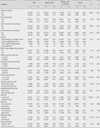Abstract
Purpose
This study was done to compare health risk behavior prevalence for youth living in metropolitan, medium sized and small cities or rural area, in order to enhance understanding regional differences.
Methods
For this study, data from the 2006 Youth Health Risk Behavior Online Survey collected by the Korean Center for Disease Control were analyzed using SPSS.
Results
In the metropolitan areas, prevalence for disease and perceived obesity were higher than in other areas. Lack of intense or moderate physical activity, obesity, fast food intake, and insufficient sleep showed higher prevalence than in rural areas. Prevalence of lifetime smoking, lifetime alcohol consumption, present alcohol use, fruit intake less than once a day, and not wearing a seat belt were higher in rural areas than in urban areas. Gender, smoking, and alcohol use were correlated. Spearman correlation between living with parent and skipping breakfast were significant. Smoking, alcohol use, and sexual behavior were correlated.
Conclusion
As significant differences in prevalence of youth health risk behaviors exist between regional areas, health education and health promotion programs considering these differences have to be developed and implemented for adolescents. Programs for prevention of smoking and alcohol use, programs for improvement of fruit intake and safety are suggested for adolescents in rural areas, whereas programs to enhance physical activity and obesity management are suggested for adolescents in metropolitan areas.
Figures and Tables
References
1. Bae YS. The comparative study on family environment, health behaviors, health state of elementary school in urban and rural areas. 1998. Daegu: Keimyung University;Unpublished master's thesis.
2. Centers for Disease Control and Prevention. Youth risk behavior surveillance-United States, 2007. Morbidity and Mortality Weekly Report. 2008. 57:SS-4. 1–131.
3. Cho NH, Lee SS, Oh YH, Moon HS, Kim SK. The recent population trend and the coping strategies. 1998. Seoul: Korea Institute for Health and Social Affairs.
4. Currie C, Gabhainn SN, Godeau E, Roberts C, Smith R, Currie D, et al. Inequalities in young people's health: International report from the HBSC 2005/06 survey. 2008. Copenhagen: WHO Regional Office for Europe;WHO Policy Series: Health policy for children and adolescents, No. 5.
5. Kang SJ. A study on health risk behavior of adolescents. 2000. Jeonju: Chonbuk National University;Unpublished master's thesis.
6. Kim OS. A study on Jeju high school student's health perception and health promotion behavior. 2003. Cheongju: Korea National University of Education;Unpublished master's thesis.
7. Kim YA. This study investigated the relationship of stress levels, social support, and health behaviors in the adolescent population. Korean Journal of Child Health Nursing. 2001. 7:203–212.
8. Kim YT, Lee HJ, Kim YJ, Jeong SH, Choi JH, Cho HM, et al. 2007 The results of Korea youth risk behaviors. 2008. Seoul: Korea Centers for Disease Control & Prevention.
9. Kim YT, Lee YK, Kim YJ, Yoon PK, Park JY, Jeong SH, et al. 2006 The results of Korea youth risk behaviors. 2007. Seoul: Korea Centers for Disease Control & Prevention.
10. Ko YK, Yoo IY, Kang KH, Lim JY, Kim MJ, Yoo HJ. Factors related to high-risk health behavior in middle school adolescents. Journal of Korean Academy of Child Health Nursing. 2006. 12:341–350.
11. Korean Institute for Health and Social Affairs. 1998 National health and nutrition survey. 1999. Seoul: Ministry for Health Welfare and Family Affairs.
12. Lee BS, Kim MY, Kim MH, Kim SY. Health belief and performance of health behaviors of some university students in Korea. Journal of Korean Academy of Nursing. 2000. 30:213–224.
13. Lee ES, Kim HY. The related factors on health risk behaviors among high school students. Journal of the Korean Society of Maternal and Child Health. 2008. 12:255–265.
14. Lee JM. A comparison of the health behavior and the health condition of the elementary school pupils in the rural areas and the urban areas. 2005. Daegu: Keimyung University;Unpublished master's thesis.
15. Park HK. Middle school seniors in the educational districts of Gangnam showed the highest academic achievements for Korean language arts, English, & mathematics in the results of scholastic ability tests taken nationwide. The Seoul Shinmun. 2009. February. 17. E4.
16. Park YJ, Lee SJ, Park ES, Ryu HS, Lee JW, Chang SO. A meta-analysis of explanatory variables of health promotion behavior. Journal of Korean Academy of Nursing. 2000. 30:836–846.
17. Perry CL. Creating health behavior change. how to develop community-wide programs for youth. 1999. Thousands Oaks, CA: Sage Publicatins, Inc.
18. Shin DH, Kim DH, Kim DH, Kim YH, Yoon YJ, Kwon CH. The smoking rate and knowledge of smoking hazards for male high school students in urban and rural areas. Journal of the Korean Academy of Family Medicine. 1996. 17:877–883.
19. Shin HS, Jung Y. Predicting and understanding schoolage children's health behavior. Journal of Korean Academy of Nursing. 1998. 28:846–855.
20. Son ES. The effects of high school student's health risk behaviors: Focused on some high school students in Guri city. 2004. Seoul: Ewha Womans University;Unpublished master's thesis.
21. Statistics Korea. 2007 Annual report on the cause of death statistics. 2008. Daejeon: Author.
22. Statistics Korea. 2007 Social indicators in Korea. 2008. Daejeon: Author.
23. Tak YR, Yun EH. Youth health risk behavior survey on adolescents in urban setting. Journal of the Korean Society of School Health. 2007. 20:11–24.




 PDF
PDF ePub
ePub Citation
Citation Print
Print






 XML Download
XML Download